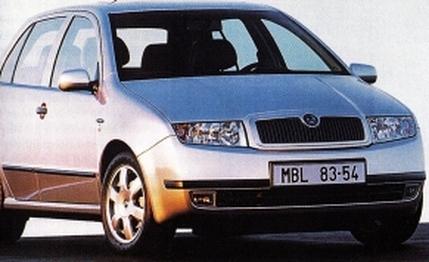 Mini Test Road Test
Mini Test Road Test
We have talked before about the Volkswagen Group's strict platform policy, in which a dozen or more separate models spring from a single underbody structure. The most productive of these platforms is the A, which has spawned the VW Golf, the New Beetle, and the Audi TT. In Europe, VW now has a smaller platform, the AO, and surprisingly, the first of the company's many marques to utilize it is Skoda, its outpost in the Czech Republic.
Not long ago, Skoda was a joke. But it has come a long way from the shoddy cars it produced before Volkswagen took over in 1991. Then, the only reason to buy a skoda was its rock-bottom price. Now, there is every reason to buy a Skoda instead of a Volkswagen. The technology is the same, but model for model, Skodas are larger and cheaper.
The AO platform's main task down the line is to produce a replacement for the Volkswagen Polo, a European model smaller than the Golf. But the current Polo has just been given an elaborate face lift and is expected to be around for at least two more years.
The first car off the AO platform is the Skoda Fabia, and it's bigger than the original Golf. In fact, the Fabia is the biggest car in the European supermini class dominated by the Fiat Punto, the Ford Fiesta, the Opel Corsa, and the Peugeot 206.
A few years ago, no one would have believed that this was a Skoda. It looks neat and up to the minute, with a long wheelbase and short body overhangs. It was designed by a Belgian, Dirk van Braeckel, who has so impressed his Volkswagen masters that he has been put in charge of the design of future Bentleys. Now that's what we call a conceptual leap.
In theory, or rather by the doctrine of VW Group chairman Dr. Ferdinand Piëch there is no reason why Skoda could not sell in the U.S., but it has no dealer network here and no plans to create one. Skoda is selling in an increasing number of countries around the world, and annual car production in the renewed Mladá Boleslav plant in Bohemia, 40 miles from Prague, is likely to reach 400,000 in 2000, 80 percent of which will be exported.
In fact, none of the AO platform's cars is destined for the US., but driving the little Fabia does provide some insight into VW's future global strategy.
Its 96.9-inch wheelbase is only two inches shorter than the Golf's and will be the standard for VW's new class of small cars. The twist-beam rear axle has been redesigned to occupy less space. The power-steering system is electrohydraulic, with the oil pressure for power assistance provided by an electric pump; this on demand' arrangement saves fuel and is easier to package in a tight Underhood area. The steering is connected by a CAN-bus system to the engine ECU.
This Skoda lacks nothing in modern safety developments. It offers anti-lock brakes and traction control, even the ESP stability system. Side airbags are optional. Most versions have air conditioning, which also feeds two dashboard compartments provide cool drinks and chocolate bars.
To begin with, the Fabia will be available with a 67-hp, 1.4-liter gas engine; a 99-hp, 1.4-liter 16-valve gas engine; and a 63-hp, 1 .9-liter diesel. Engines to be introduced later include a 49-hp, 1.0-liter pushrod four; a 118-hp, 2.0-liter gas engine; and a 97-hp, 1 .9-liter turbo-diesel. The two entry-level gas motors are Skoda' own; all others are VW Group units.
The Fabia is the most spacious in its five-door-hatchback class. It also turns out to be one of the best-driving and -riding cars of this size, and it's priced across Europe at some five percent less than its competitors. Skoda can easily do this because Czech labor costs are only 20 percent of those in Germany; the labor content of the cars' price is only six per-cent; that figure is 25 percent in VW's hometown. Not surprising, then, that in. addition being the fastest-growing part of the VW empire, Skoda is buying an increasing number of components and materials for the VW Group.
What's next? Unlikely as it may seem an executive-class Skoda. In 2901 Skoda will launch a sedan that is bigger than anything it has offered since the 1 930s Codenamed B-plus, it's related to the VW Passat but will have the VW Group's new modular V-8 engine. It is intended to rival cars like the Opel Omega {the basis of the Cadillac Catera).
Detlef Wittig, the VW director who has presided over Skoda's move onward and upward, says confidently, "In a couple of years, Skoda will be ready for that."